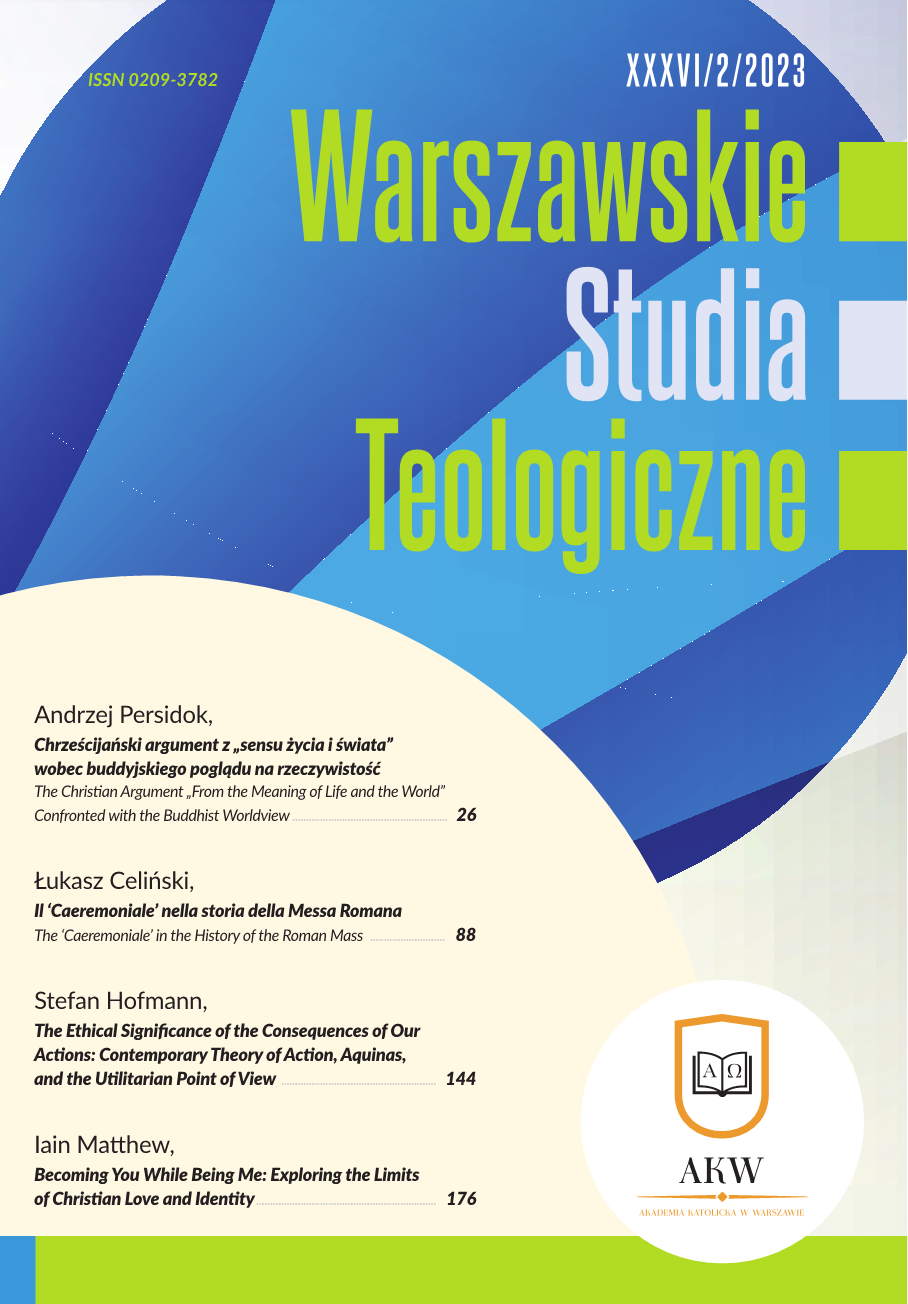Ecclesiology of the Epistle to the Ephesians 1:22b-23
Mateusz Nycz
Uniwersytet Kardynała Stefana Wyszyńskiego, Wydział Teologiczny (Poland)
Abstract
The epistle to the Ephesians is seen as an ecclesiological scripture among the exegetes. It contains a rather systematic interpretation of what the Church is, what her role and attitude to Christ is. The sentence from Ephesians 1: 22b-23 may pass as the most important passage for the entire ecclesiology of the Letter to the Ephesians.This short passage causes many interpretative difficulties at the grammat-ical level, such as: interpretation of the term pleroume,nou as active or passive par-ticiple, function of the terms evkklesi,a, pa/j and auvtou/ in the syntax and the role of the expression u`pe.r pa,nta in the sentence. In addition, it is necessary to properly read the meaning of the term plh,rwma.The title text has been subjected to grammatical and lexicographical anal-ysis. Such way of analysis allowed for a proper reading of the attitude of Christ to the Church – Christ fills the Church (and not the reverse as it might be judged by a cursory morphological analysis) and only He is the head of the Church. He fills the whole Church of the fruits of his passion, death and resurrection.
Keywords:
Ephesians, Ecclesiology, Church, Fullness, Head, BodyReferences
Barth, M. (1974). Ephesians 1–3. AB 34. New York.
Google Scholar
Bartnicki, R. (2006). Dary Ducha Świętego w świetle tekstów biblijnych. WST 19, 174–181.
Google Scholar
Best, E. (1998). A Critical and Exegetical Commentary on Ephesians. London–New York: ICC.
Google Scholar
Beuken, W., Dahmen, U. (2004). var. W: G. J. Botterweck, H. Ringgren, H.-J. Fabry (red.), Theological Dictionary of the Old Testament. T. 12 (248–259). Grand Rapids.
Google Scholar
Blass, F., Debrunner, A. (1961). A Greek Grammar of the New Testament and Other Christian Literature. Chicago.
Google Scholar
Brown, R. (1997). An Introduction to the New Testament. New York: ABRL.
Google Scholar
Bruce, F. F. (1984), The Epistles to the Colossians, to Philemon and to the Ephesians. NICNT 13. Grand Rapids.
Google Scholar
Chrostowski, W. (2015). Między Synagogą a Kościołem. Dzieje św. Pawła. Kraków.
Google Scholar
Dąbrowski, E. (2013). Dzieje Pawła z Tarsu. Warszawa.
Google Scholar
Ellinger, E., Rudolph, W. (1997). Biblia Hebraica Stuttgartensia. Stuttgart.
Google Scholar
Furnish, V. P. (1992). Ephesians, Epistle to the. W: Anchor Bible Dictionary. T. 2 (535 –542). New York.
Google Scholar
Hoehner, H. W. (2002). Ephesians: An Exegetical Commentary. Grand Rapids.
Google Scholar
Jankowski, A. (1962). Listy więzienne świętego Pawła. Do Filipian – do Kolosan – do Filemona – do Efezjan. Wstęp – Przekład z oryginału – Komentarz. PŚNT 8. Poznań.
Google Scholar
Jeal, R. R. (1990). The Relationship between Theology and Ethics in the Letter to the Ephesians. Sheffield.
Google Scholar
Jelonek, T. (2011). Teologia biblijna. Kraków.
Google Scholar
Jougan, A. (2013). Słownik kościelny łacińsko-polski. Sandomierz.
Google Scholar
Kręcidło, J. (2015). Pojednanie podzielonej ludzkości z Bogiem przez krzyżową śmierć Chrystusa. Rozwój chrystologicznej, soteriologicznej i eklezjologicznej argumentacji w Ef 2,11-22. SNT 10, 199–220.
Google Scholar
Lamarche, P. (1994). Pełnia. W: Leon-Dufour, X. (red.), Słownik teologii biblijnej (655–656). Poznań.
Google Scholar
Langkammer, H. (1996). List do Efezjan. W: Rubinkiewicz, R. (red.), Wstęp do Nowego Testamentu (376–381). Poznań.
Google Scholar
Linke, W. (2015). Uwierzyć w Chrystusie (Ef 1,13.15)? Jezus Chrystus a wiara Kościoła w Efezie. WST 28 (4), 138–155.
Google Scholar
Nestle, Eb., Nestle, Er., Aland, B., Aland, K. (2012). Novum Testamentum Graece. Stuttgart.
Google Scholar
Piwowar, A. (2016). Składnia języka greckiego Nowego Testamentu. MPWB 13. Lublin.
Google Scholar
Purcell, W. M. (1996). Ars Poetriae: Rhetorical and Grammatical Invention at the Margin of Literacy. Columbia.
Google Scholar
Roloff, J. (2008). Wprowadzenie do Nowego Testamentu. Warszawa.
Google Scholar
Roon, A. Van (1974). The Authenticity of Ephesians. NovTSup 39. Leiden.
Google Scholar
Rosik, M. (2009). Pierwszy List do Koryntian. NKB.NT 7. Częstochowa.
Google Scholar
Rudolph, K. (2011). Gnoza. Istota i historia późnoantycznej formacji religijnej. Classica Religiologica 4. Kraków.
Google Scholar
Schnelle, U. (2009). Theology of the New Testament. Grand Rapids.
Google Scholar
Schweizer, E. (1971). sa,rx. W: Kittel, G., Friedrich, G. (red.), Theological Dictionary of the New Testament. T. 7 (98–151). Grand Rapids.
Google Scholar
Schweizer, E. (1971). sw/ma. W: Kittel, G., Friedrich, G. (red.), Theological Dictionary of the New Testament. T. 7 (1024–1094). Grand Rapids.
Google Scholar
Turner, N. (2003). A Grammar of New Testament Greek J. H. Moulton. T. 3: Syntax. London–New York.
Google Scholar
Ushami, K. (1983). Somatic Comprehension of Unity: The Church in Ephesus. ABib 101. Rome.
Google Scholar
Weber, R., Gryson, R. (2007). Biblia Sacra iuxta vulgatam versionem. Stuttgart.
Google Scholar
Authors
Mateusz NyczUniwersytet Kardynała Stefana Wyszyńskiego, Wydział Teologiczny Poland
Ks. mgr lic. Mateusz NYCZ – kapłan Archidiecezji Warszawskiej, doktorant Wydziału Teologicznego Uniwersytetu Kardynała Stefana Wyszyńskiego (teologia biblijna). W 2014 r. uzyskał tytuł zawodowy magistra teologii na Uniwersytecie Papieskim Jana Pawła II w Krakowie, a w 2017 r. stopień naukowy licencjata w zakresie teologii biblijnej. Posługuje jako wikariusz w parafii pw. Dzieciątka Jezus w Warszawie.
Statistics
Abstract views: 465PDF downloads: 163

